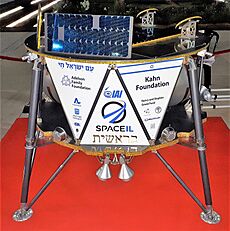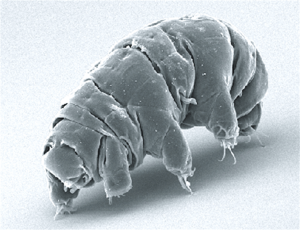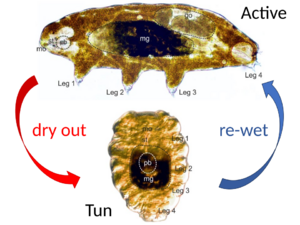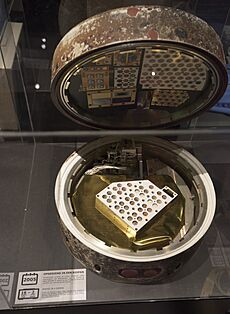Tardigrades in space facts for kids
Tardigrades, also known as water bears, are tiny animals famous for being incredibly tough. Because they can survive extreme conditions like radiation, scientists became interested in sending them to space. Their first journey began in 2007 on the FOTON-M3 mission. They were exposed to the vacuum of space for 10 days and came back to life on Earth after just being given water.
Since then, tardigrades have traveled to the International Space Station in 2011. In 2019, a group of tardigrades even crash-landed on the Moon aboard the Israeli spacecraft Beresheet. These missions help scientists understand how life might survive beyond Earth.
Contents
What Are Tardigrades?
Tardigrades are tiny creatures, usually less than a millimeter long. They are related to arthropods like insects and spiders. Many live in damp places like moss, where they often dry out and get wet again. Others live in very cold places like the Arctic or on high mountains.
Their amazing survival skill is called cryptobiosis. When their environment becomes too dry, they curl up into a ball called a "tun." In this state, their body shuts down almost completely. They can stay like this for years, waiting for conditions to improve.
Tardigrades are often called the toughest animals on Earth. They have special proteins called Dsup that protect their DNA from being damaged by things like radiation. This makes them perfect for studying survival in the harsh environment of space.
Tardigrades' Space Adventures
Scientists have been curious about sending tardigrades to space since the 1960s. They wanted to see if these hardy animals could handle the dangers outside our planet, like radiation and the lack of air.
First Trip to Orbit: The FOTON-M3 Mission (2007)
In 2007, tardigrades became the first animals to survive being exposed to outer space. They were sent into low Earth orbit on a mission called FOTON-M3.
Scientists ran a few experiments:
- Some tardigrades were exposed only to the vacuum of space.
- Others were exposed to both the vacuum and the sun's powerful ultraviolet (UV) radiation.
When they returned to Earth, more than 68% of the tardigrades protected from UV rays were revived with water. Many of them went on to lay healthy eggs.
However, the tardigrades exposed to both vacuum and UV radiation had a much harder time. Only a few survived. This showed that while tardigrades are tough, the combination of vacuum and direct solar radiation is extremely dangerous.
A Visit to the Space Station (2011)
In 2011, another group of tardigrades took a trip on the Space Shuttle Endeavour. They traveled to the International Space Station as part of an experiment called TARDIKISS.
The goal was to see how tardigrades handled microgravity (the feeling of weightlessness) and cosmic radiation over a longer period. The results showed that these conditions didn't really harm the tardigrades. This confirmed that they are excellent model organisms for space research and the study of life in space, known as astrobiology.
A Crash Landing on the Moon (2019)

In 2019, a private Israeli mission sent a lander named Beresheet to the Moon. Onboard was a "lunar library" containing human knowledge and samples, including thousands of tardigrades in their dehydrated 'tun' state.
Unfortunately, the lander crashed on the Moon's surface. Experts believe the tardigrades were unlikely to have survived the impact. The pressure from the crash was probably far greater than what they are known to withstand.
Even if some did survive, they would remain in their 'tun' state forever. To wake up, grow, and reproduce, they would need liquid water, which is not available on the Moon's surface.
This event sparked conversations about planetary protection. Space agencies have rules to avoid accidentally spreading Earth life to other planets and moons. While spilling tardigrades on the Moon wasn't against any specific law, it highlighted the need for clear guidelines for all space missions.




